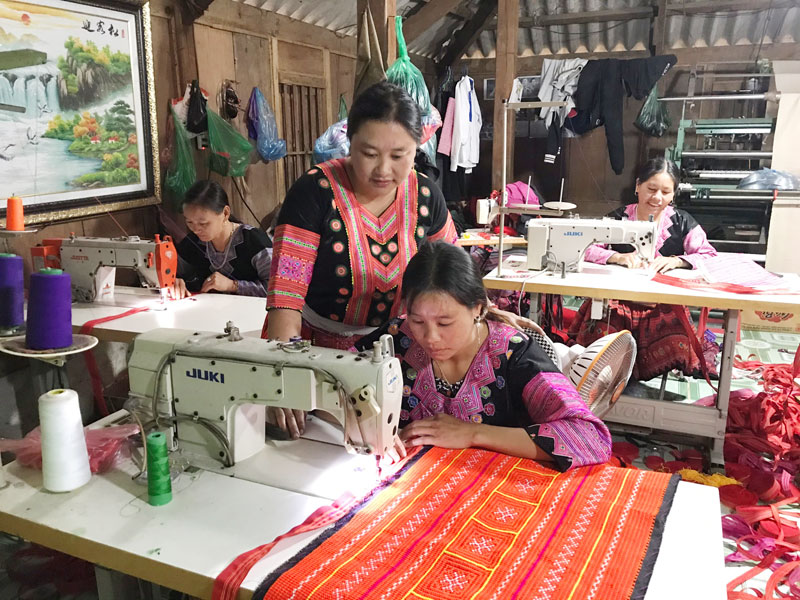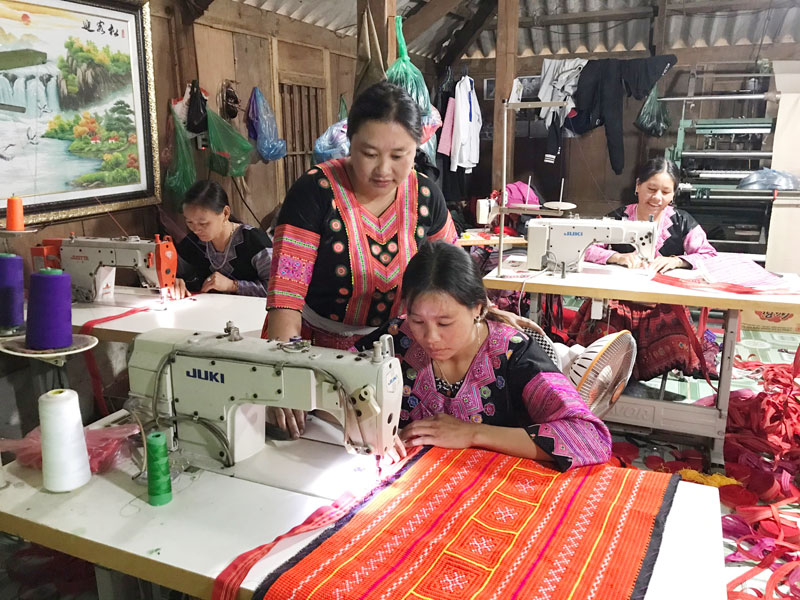
(HBO) - Brocade weaving has long been associated with the daily life of Mong ethnic people in Hang Kia commune, Mai Chau district. It has been passed down from generation to generation, bearing the unique culture of Mong ethnic people.
 Brocade weaving and garment factory of Ms. Vang Y Danh in
Hang Kia hamlet, Hang Kia commune (Mai Chau) has been creating jobs for the
local laborers with an average income of 2.5 - 3 million VND a person per
month.
Brocade weaving and garment factory of Ms. Vang Y Danh in
Hang Kia hamlet, Hang Kia commune (Mai Chau) has been creating jobs for the
local laborers with an average income of 2.5 - 3 million VND a person per
month.
On the occasion of any festival or New Year, Mong boys and girls often wear brocade clothes, dresses and white silver rings and bustle together to the markets, the plum or peach gardens with blooming flowers to have a talk. The vibrant colors and the eye-catching brocade patterns on shirts and skirts have created the spiritual vitality, a special highlight in Mong ethnic culture.
In the past, the brocade products of Mong ethnic people only
served for the family’s needs and the rituals. Now brocade products have become
a commodity, favored by many domestic and foreign tourists. To meet the market
demand, especially the increasing number of tourists coming to the ethnic
minority areas, the textile products are becoming more and more diverse in
types and designs such as handbags, wallets, caps, scarves, phone boxes, key
chains ... with many beautiful colors. The brocade products from Ms. Danh's
textile factory are available at most souvenir shops, homestays in and outside
the region to serve tourists.
Mr. Vang A Thao, the Vice Chairman of People's Committee of
Hang Kia Commune, says: "Ms. Danh's brocade textile factory as well as many
other textile and garment establishments in the region is an effective economic
model associated with tourism services, creating jobs and improving income for
the local people. At the same time, it helps to create jobs and income for
laborers in the region. At the same time, it contributes to preserving the
national cultural identity and improving the spiritual life of the Mong ethnic
people.”
With an increasingly vibrant and widespread emulation movement aimed at building cultured residential areas and cultured families, Yen Thuy District has been making steady progress toward improving both the material and spiritual well-being of its people, while fostering a civilized, prosperous, beautiful, and progressive community.
Once lacking recreational spaces and community facilities, Residential Group 2 in Quynh Lam Ward (Hoa Binh City) has recently received attention for the construction of a new, spacious, and fully equipped cultural house. The project followed the model of state support combined with public contributions in both labor and funding.
The "All people unite to build cultural life" movement, which has been effectively integrated with Kim Boi district’s socio-economic development goals, is fostering a lively spirit of emulation across local residential areas, hamlets, villages, public agencies, and enterprises. In addition, through the initiative, traditional cultural values are being preserved and promoted, while community solidarity and mutual support in poverty reduction and economic development are being strengthened.
A working delegation of the Hoa Binh provincial People’s Committee led by its Permanent Vice Chairman Nguyen Van Toan on June 11 inspected the progress of a project to build the Mo Muong Cultural Heritage Conservation Space linked to tourism services in Hop Phong commune, Cao Phong district.
Born and growing in the heroic land of Muong Dong, Dinh Thi Kieu Dung, a resident in Bo town of Kim Boi district, in her childhood was nurtured by the sweet lullabies of her grandmother and mother. These melodies deeply imprinted on her soul, becoming an inseparable part of her love for her ethnic group's culture. For over 20 years, this love for her hometown has driven Dung to research, collect, and pass down the cultural values of the Muong people to future generations.
In the final days of May, the Ethnic Art Troupe of Hoa Binh Province organized performances to serve the people in remote, mountainous, and particularly disadvantaged areas within the province. These were not just ordinary artistic shows, but they were the meaningful journeys aimed at spreading cultural values, enhancing the spiritual life of the people and contributing to the preservation of ethnic minority cultural identities.



 Brocade weaving and garment factory of Ms. Vang Y Danh in
Hang Kia hamlet, Hang Kia commune (Mai Chau) has been creating jobs for the
local laborers with an average income of 2.5 - 3 million VND a person per
month.
Brocade weaving and garment factory of Ms. Vang Y Danh in
Hang Kia hamlet, Hang Kia commune (Mai Chau) has been creating jobs for the
local laborers with an average income of 2.5 - 3 million VND a person per
month.